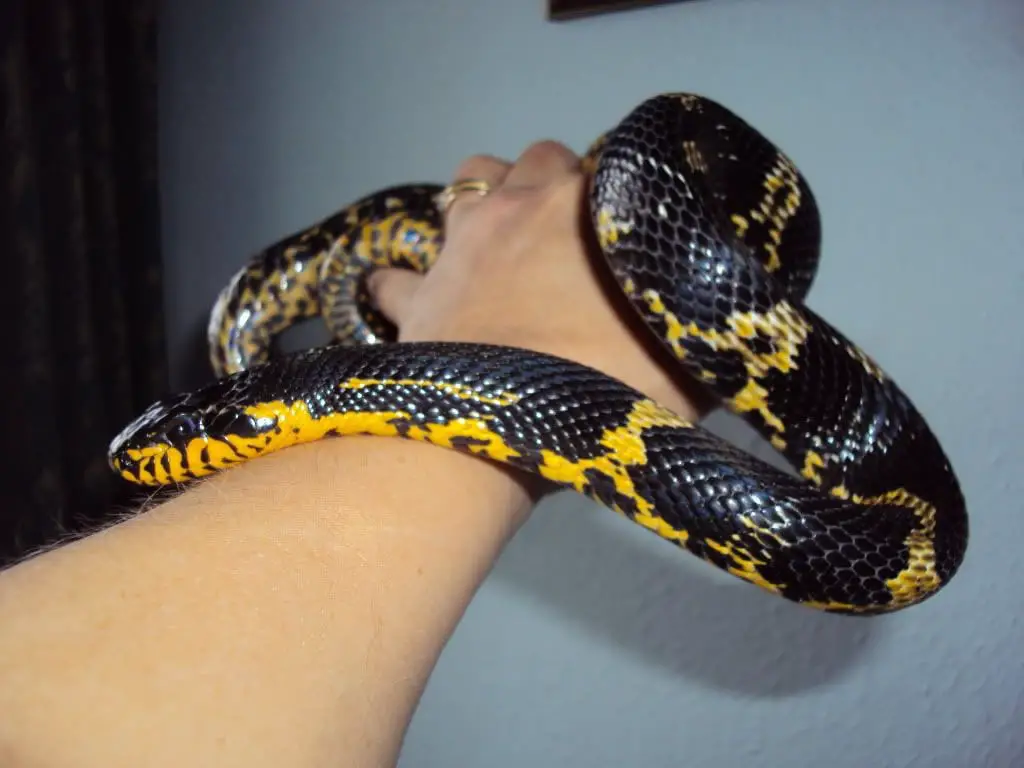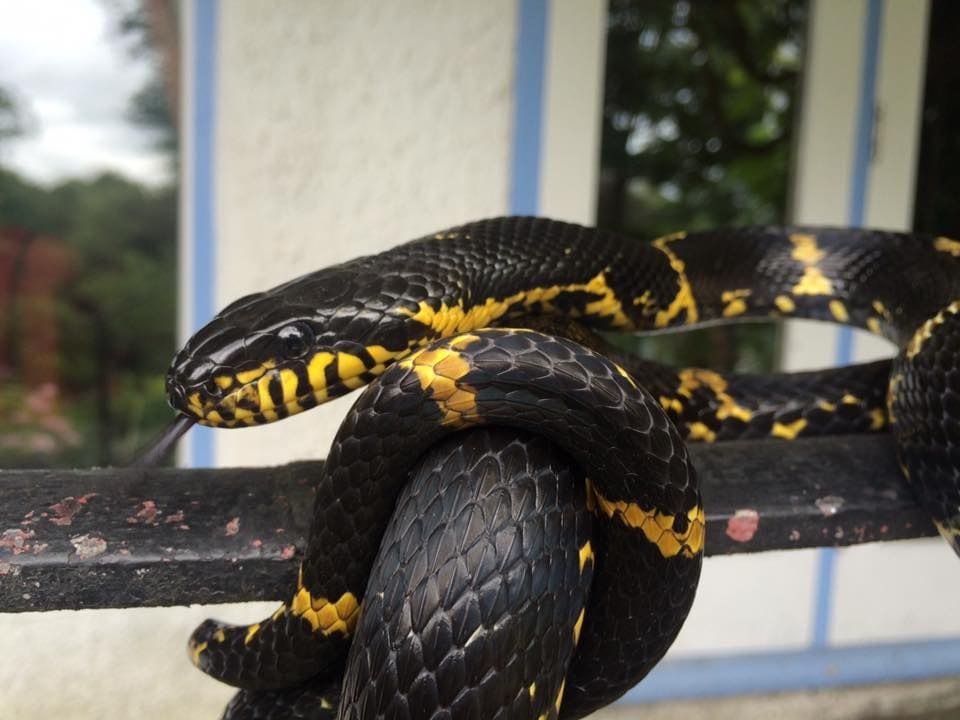Scientific Facts
| Common Name: | Russian rat snake |
| Scientific Name: | Elaphe schrenckii |
| Life Span: | 15 years and above |
| Size: | 5 feet |
| Country of Origin: | Korea, China, Mongolia, and Russia |
Physical Description
The Russian rat snakes are large and non-venomous snakes that are so active throughout the day. They live in various environments: mountains, forests, swamps, farmlands, and riverbanks. While they may change their colors from time to time and there are just 3 verified color variants, they compensate this with excellent personalities.
These snakes are so easy to keep, making them ideal for novices. The Russian rat snakes are docile, but the curious and active attitude of these snakes are making them excellent display snakes. Those characteristics are appealing even to those who have been keeping reptiles for a long time.
These snakes are quite short to average-sized. Many of them reach the length of just 5 feet, which makes them even much easier to handle. The Russian rat snakes are believed to be the ugly ducklings among the snakes. Juvenile snakes come in gray or brown skin with light crossbands. They look dirty, which may make them not a good choice for people who want beautiful snakes. They might be hardly called beautiful.
Adults are typically dark brown or black with cream or yellow crossbands. Their markings resemble those of the eastern kingsnakes with just one big difference: the bright yellow shade that usually adorns the adult’s face. The coloration on the lower and upper labial scales is giving the Russian rat snakes that eye-catchy contrast.
Aside from those contrasting markings, the size of Russian rat snakes makes them impressive and much more interesting to behold. Adults can sometimes grow for up to 5 to 6 feet long. In a few cases, these snakes grow up to 8 feet long.
Life Span
In most cases, the Russian rat snakes last for 15 years or more. Their life span may extend to a few more years with proper husbandry.
Range and Habitat
Native to northeast China, eastern Asiatic Russia, and some portions of Mongolia and Korea, the Russian rat snakes are usually seen in those areas surrounding the Amur River.
These snakes prefer wetlands, though they can also be spotted in numerous habitats, which include the sparsely vegetated regions, rocky hillsides, woodlands, and farmlands. Like most snakes, they seem to be okay with clearings and forest edges.
The Russian rat snakes have a brief active season within the forest. Subject to cold and long winter, they might be out from May until September in certain portions of the range.
Breeding and Brumation
The Russian rat snakes take 4 to 5 years to reach sexual maturity. Younger males can breed. These snakes do not breed successfully with no brumation. Females won’t lay eggs until the brumation period is over. You may encourage these snakes to hibernate by setting the temperature between 47 and 54 degrees Fahrenheit for 3 months. However, some breeders suggest a cooling period of up to 5 months.
Even at the low temperatures, the Russian rat snakes stay active. However, they can be sluggish than usual. When encouraging these snakes to undergo brumation, keepers stop giving them food for the next 2 to 3 weeks before the brumation period. This will help ensure no food is left in their stomachs. Lower the temperatures through some weeks until they reach the brumation level.
After brumation, force your snakes to wake up by just plugging in the heat pad, allowing it to do the rest. The basking light should stay on for 8 hours each day and slowly increase the photoperiod in 4 months until the cycle becomes 14 hours of light and 10 hours of darkness by mid-June.
The females will lay 6 to 12 eggs after the brumation period. If you don’t have an incubator, then you may keep the eggs underneath lighting with the ambient temperature of 82 degrees Fahrenheit. This will help the colubrid eggs to hatch at the right time.
For the egg box, you can use a container made of plastic with holes. This plastic container must be big and spacious enough for the eggs that are partially buried in wet perlite. The eggs should stay on top of the substrate, allowing the air to come in and circulate. Expect the eggs to hatch in 40-60 days.
The Russian rat snakes are the same as husbandry for kingsnakes, milk snakes, and some other species of rat snakes. The hatchlings must stay in the rack system. You may keep them in boxes that measure 12” long, 7” wide, and 3” tall.
The enclosure of your pet should have the necessary accessories and furnishings like the water bowl, hide boxes, and a substrate made of old newspapers. This setup is suitable for young snakes in the first 6 months or longer of their lives. Switch to a bigger enclosure once your pet grows longer.

Behavior
Though the Russian rat snakes have bigger heads, they may still settle for smaller food items. They are great eaters. Also, they love to climb. They often take advantage of climbing the branches within their enclosure. Therefore, the aquarium of your pet must be 24 inches tall or higher.
Adults may grow for 5 feet or longer. They are also heavy-bodied like corn snakes. While these snakes are docile, they are somewhat strong and curious. It can make opening and cleaning their enclosure slightly challenging.
Housing
Since the Russian rat snakes are active species, their enclosures must be wider and taller to have some space for their favorite hobby – climbing. The hatchlings may stay in the little racks or tubs as they can be shy at first. They may get stressed if you keep them in bigger enclosures.
Make sure the enclosure of your pet is escape-proof. Remember, the Russian rat snakes are strong even as hatchlings. A pair of adult snakes can be kept in an enclosure measuring 5 feet long, 2 feet wide, and 2 feet tall. However, if you can provide them with a bigger enclosure, that would be great.
The Russian rat snakes are also fine when kept in the vertical cages since climbing is their favorite pastime. They will use the entire space available in the enclosure. Feel free to add new climbing branches and change the existing decoration to keep the snakes happy.
They’re calm and do not stress easily, so many of the breeders keep them in the big and communal tanks. However, keep in mind that it is a controversial topic. Therefore, you must research it before deciding when you wish to keep the snakes together. Also, try to make the enclosure look as natural as possible by adding tree trunks and artificial plants designed for foliage.
Hide Box
Though these snakes are so inquisitive and active, they require a hide box. They give at least 2 hides in every tip of the enclosure. You can use the flowerpots, boxes, hollow tree trunk, or anything large enough for the snake.
Substrate
The hatchlings are best to keep on the paper towels because keeping their health in check is much easier if you use this tactic. For young and adult snakes, the two most famous substrates to use are coco coir and aspen bedding. At times, the Russian rat snakes want to burrow, and these substrates are good for this purpose. If you choose to use coco coir, then keep its surface a bit wet.
Heating and Lighting
As diurnal creatures, the Russian rat snakes would benefit from using full-spectrum fluorescent tubes on a 12-hour cycle. You will then see them basking under these tubes. The enclosure of your pet should have both cool and warm sides.
The cool part should stay a temperature between 21 to 28 degrees Celsius or 70 to 82 degrees Fahrenheit. For the warm side, the temperature must be 28 degrees Celsius or 82 degrees Fahrenheit. The temperature for both sides of the enclosure must stay at the ideal range as it helps a lot the snakes in digesting their food properly. What’s more interesting is that the Russian rat snakes are not sensitive to high temperatures even when it reaches 35 degrees Celsius or 95 degrees Fahrenheit.
Water
The Russian rat snakes are good swimmers, so give your pets with a large water bowl that can accommodate their entire bodies. The larger the water bowl, the better. You may use tap water, which you need to replace as often as possible.
Humidity
Aside from the water, humidity is also crucial. Spray the entire enclosure with water once every few days. Doing this will help a lot. Keep the humidity level within the cage higher as it will help your pet to shed its skin easily.
Feeding
In the wild, the snakes eat fish, rodents, and the eggs of birds. You can feed your pet with these food items in frozen/thawed form. Hatchlings should eat once every 3 to 4 days as they can grow fast. Adults should eat once every 2 weeks. They are okay with one medium-sized rat or 2 adult mice.
The metabolism of these snakes is quite fast, and some of them have an outrageous feeding response. Many of them prefer smaller food items but in larger quantities. Some species may refuse to eat in winter months, as they bromate during this period. You can’t feed your pet throughout this period.
Handling
These snakes are amazingly inquisitive. They love exploration. Hatchlings and young snakes can be slightly timid and jumpy when you try to touch them. Just give it time. In the end, these snakes will realize that you are not a threat. From that moment, these snakes will calm down and allow you to touch them.
Adult snakes usually climb on the hands of their keepers while changing the water and doing spot cleaning. Since these are hardy creatures that can grow well in room temperatures, the Russian rat snakes are more responsive to handling compared to tropical snakes. When scared, they may run and not bite. However, they are mostly curious instead of scared. All these things are making them excellent reptile pets that are okay with handling. Many of them enjoy being handled because they interpret it as a chance to explore their surroundings outside the enclosure.
Shedding
Just keep the humidity level inside the enclosure at the best level. This way, your pets will be able to shed properly.
Cleaning
Since the Russian rat snakes have a faster metabolism, you need to clean their enclosures more often than usual. They may defecate in the water bowl, so always check it from time to time. Feces may also be around the logs and artificial plants, so do routine inspection and cleaning. Spot cleaning should be done every day. General cleaning is a must when the enclosure begins to appear messy. Change the substrate and clean the walls.
Possible Health Issues Among the Russian Rat Snakes
The Russian rat snakes are so hardy, so they might be resistant enough against more diseases except for some problems like mites. Mites can spread when you keep a snake having them together with the uninfected species.
Breeding females can also lead to egg-bound. If you’re keeping your pets in extremely poor conditions, they may acquire scale rot, mouth rot, or a respiratory infection. Also, these snakes can be prone to obesity considering their outrageous response to food. Many of them eat smaller food items but are willing to take more pieces in every feeding time. Always watch your pet’s food portions in every feeding.
Availability – Where to Get One?
The Russian rat snakes are widely available at the local pet stores and breeders. You may also look for them through the famous online pet stores.
How to care for a Russian Rat Snake?
Keep the snake healthy and happy by providing everything it needs. Provide it with a bigger enclosure, a good choice of substrate, healthy food items, a water bowl, and other necessary decorations for the enclosure.
FAQs
Are the Russian rat snakes good swimmers?
The Russian rat snakes are great swimmers. So, provide them with a big water bowl containing fresh and clean tap water.
Are Russian rat snakes friendly?
Yes, the Russian rat snakes are friendly though they can be nervous and jumpy at first. These snakes, however, tend to be curious instead of scared.
Do Russian rat snakes love being handled?
The Russian rat snakes are friendly. With proper handling, they eventually show themselves happy when being handled.
Are Russian rat snakes easy to feed?
Yes, the Russian rat snakes are easy to feed. They have an incredible feeding response.
How long do Russian rat snakes grow?
In most cases, the Russian rat snakes grow up to 5 to 6 feet. In rare cases, they grow up to 8 feet.



